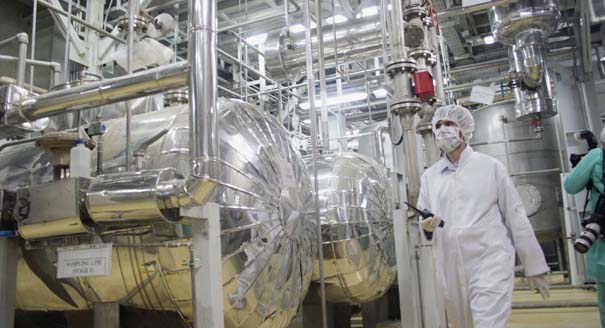Source: Nonproliferation Review
A storm is brewing over the spread of sensitive nuclear technology that will be hard for the United States to weather without an updated nonproliferation strategy. A handful of US allies in Northeast Asia and the Middle East have refused to foreclose the option to develop enrichment or reprocessing (ENR) facilities for civilian nuclear-energy programs. There is no legal prohibition on developing either technology under the terms of the Treaty on the Non-Proliferation of Nuclear Weapons (NPT), so long as the country permits international monitoring of peaceful use. Yet ENR technology can be used to produce the fissile material that forms the core of a nuclear weapon.1 The United States has therefore pursued additional measures over the decades to deny even its closest partners from surmounting this technical chokepoint to the bomb.2
The last two US administrations attempted to erect new barriers to the supply of sensitive technology. In 2004, President George W. Bush called for the leading group of nuclear suppliers to ban the sale of ENR technology to states that did not already have it, but the proposal failed to garner political consensus.3 The Barack Obama administration fell back on a bilateral approach that sought to make some US agreements for civil nuclear cooperation conditional on the recipient country forswearing ENR technology. By baking strict restrictions into nuclear cooperation agreements—colloquially known as 123 agreements after the relevant section of the 1954 US Atomic Energy Act—this effort was supposed to usher in a new nonproliferation “gold standard.”4 Although the United Arab Emirates (UAE) and Taiwan accepted this restriction, Washington found it difficult to convince Vietnam, Jordan, the Republic of Korea, or Saudi Arabia to follow suit.
The traditional nonproliferation toolbox of technology denial, coercion, and incentives provided past US administrations with a range of effective options from which to choose. But denying access to technology is becoming difficult to enforce as the global role of the United States nuclear industry continues to shrink. Allies, particularly those within the Non-Aligned Movement (NAM), can turn to an alternative field of nuclear suppliers—notably France, Russia, and eventually China—that are eager to offer a full range of nuclear fuel-cycle services without the stringent nonproliferation requirements demanded by the US government. Furthermore, sanctioning or even censuring allies is hard and painful. Given the mutual economic and security benefits derived from US alliance relationships today, there is little desire in Washington to incur the damage of coercing allies over civilian nuclear technology concerns.
As technology denial and coercion become tough options to employ, the United States should consider shifting toward a strategy of “buying out” an ally’s sensitive nuclear program. Substantial packages of political, economic, and military assistance may entice US allies not to exercise their option under Article IV of the NPT to develop the full nuclear-fuel cycle.5 To be clear, an inducement strategy is not a wholly new policy recommendation: the US government has long been aware of the leverage gained by rewarding countries for strengthening and brandishing their nonproliferation bona fides. The novel twist identified in this article is that inducements are only likely to succeed if offered at the earliest stage of technical development, before a country builds capabilities that will be difficult or expensive to trade away. The United States can use its relative leverage at this phase to incentivize countries without ENR capabilities from ever pursuing these sensitive technologies in the first place.
The case for inducements proceeds in four main parts. The first reviews the relative merits and costs of several modern US nonproliferation policy options— notably technology denial and coercion—toward allies. The second section lays out the logic of offering inducements to nuclear newcomers in exchange for a credible commitment to forgo ENR technology. One key finding here is that inducements are unlikely to be effective on mature civil nuclear-energy programs such as those in Japan or South Korea, but do hold promise for Saudi Arabia or Jordan. The third part confronts the practical challenges of this proposed policy course, notably the high risk of moral hazard and strong pushback from NAM countries if the United States insists on legally binding pledges to forswear ENR. The final fourth section identifies a path forward to provide US negotiators with the flexibility to bargain for the most stringent yet practical set of ENR restrictions possible.
This article was originally published in Nonproliferation Review.
Notes
1 A first-generation nuclear weapon generates effects by rapidly combining pieces of fissile material into a supercritical mass to enable a nuclear-chain reaction. A gun-type slams together subcritical masses of highly enriched uranium (HEU). An implosion weapon surrounds a subcritical mass of plutonium or HEU with high-explosive material that is used to compress the fissile material into a denser, supercritical mass. See US Department of Energy, Restricted Data Declassification Decisions 1946 to the Present (RDD-7, Office of Declassification, January 2001).
2 Francis J. Gavin, “Strategies of Inhibition: U.S. Grand Strategy, the Nuclear Revolution, and Nonproliferation,” International Security 40 (Summer 2015), pp. 9–46.
3 Wade Boese, “Bush Outlines Proposals to Stem Proliferation,” Arms Control Today, March 1, 2004, www.armscontrol.org/act/2004_03/Bush.
4 Fred McGoldrick, “Limiting Transfers of Enrichment and Reprocessing Technology: Issues, Constraints, Options,” Project on Managing the Atom, Harvard University, May 2011, http://belfercenter.ksg.harvard.edu/files/MTA-NSG-report-color.pdf.
5 “Nothing in this Treaty shall be interpreted as affecting the inalienable right of all the Parties to the Treaty to develop research, production and use of nuclear energy for peaceful purposes without discrimination and in conformity with” the NPT. Treaty on the Non-Proliferation of Nuclear Weapons, March 5, 1970, Article IV, paragraph 1.





